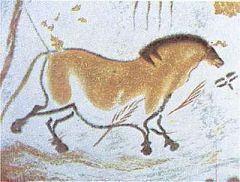

the archetypal mythology of horses
Copyright
2004-2022 Beverley Kane, MD
Page 7 of 20
dinner?
5
By the first millennium, numerous
cultures abound with myths, folk tales, and
rituals involving the horse, including a form of
horse suttee—where horses were buried with
their masters.
Until recently, horse tales were told by
and to people who were familiar with physical
horses in daily life. In the age of the tractor and
the automobile and the snowboard, horse myths
are spread by the mass media to people,
especially children, who have little or no contact
with live horses. Old movies such as National
Velvet, the Black Stallion, Ben Hur, and Equus, and newer movies such as Spirit, Lord of
the Rings, Seabiscuit and Hidalgo proffer mainly archetypal images to a new generation
of dreamers.
The following sections describe the most significant Jungian archetypes and how
the horse portrays each archetype in mythology.
ANIMUS/ANIMA/GENDER COMPLEMENT
Animus and anima are the archetypal figures that hold, respectively, masculine and
feminine qualities. Masculine, or yang, qualities are traditionally active, penetrating,
aggressive, assertive, hard, dominant and rational. The feminine, or yin, is associated
with passivity, acceptance, nurturing, receptivity, envelopment, softness, and intuitive
processes.
In Jung's time, the animus was a woman's "inner man" and the anima was a man's
"inner woman." In a predominantly heterosexual society
*
conditioned by the persistent
influences of the 20th century, Jung's definitions remain relevant and useful in the
interpretation of dreams and myths. But because masculine and feminine do not
necessarily equate with or attach to biological males and females, and because there are
so many variations of intergender and transgender identities, the term gender
complement denotes the set of opposite or missing gender qualities that complete each
individual. Strong projections onto one's gender-complementary person are often
experienced as sexual attraction or falling in love.
One of the more remarkable aspects of a living horse is that he dually expresses
both strong masculine and strong feminine qualities. On one hand the horse's physical
powers suggest the strongman figure whom Jung's student Maria-Louise von Franz uses
to exemplify the wholly physical man, one of the four stages of the animus.
6.7
On the
other hand, in The Tao of Equus, Linda Kohanov claims that horses relate to the world
*
Demographers estimate that between 5 and 9 percent of the US population self-identify as gay, lesbian,
bisexual or transgender—Harris Interactive www.harrisinteractive.com/pop_up/glbt/ 2004
Cave drawing at Lascaux,
France. –14,000


